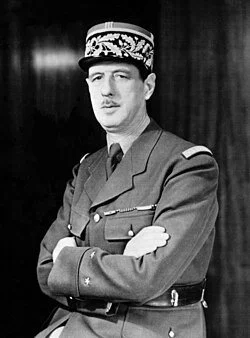In 1932, in a desperate bid to stay in power, the conservative politicians in Germany cynically offered a power sharing agreement with Adolf Hitler. Hitler was even more cynical and unprincipled than the conservatives; in less than a year, the conservatives were completely out of power. [See “Stuck in the (Center Right) With You”, 7/27/2020]
After a few years of bludgeoning Germany into submission, Hitler went after France. He hated France because it had insisted on punishing Germany after World War I. Germany was forced to pay crushing reparations, to demilitarize its border with France, and limit the size of the German military. Hitler promised to make Germany great again by destroying their old enemy, France.
When Hitler attacked in 1940, France was a political, social, and military mess. France was still recovering from the fallout caused by the Dreyfus Affair (1894 – 1906), when the highest-ranking Jewish officer was falsely accused of treason to cover up the actual treason by another officer who had better political connections. Politicians and the military high command backed each other’s lies until it became impossible to distract public attention from the truth.
The Dreyfus Affair fractured French society, revealing deep pockets of antisemitism and intolerance. It discredited the main political parties allowing the rise of new parties ranging from fascists to socialists, conservatives to communists. Protestants and Catholics fragmented into support for each political faction, except the communists who were anti-religious.
The French still believed in their “Grand Army” which had conquered Europe for Napoleon more than 100 years earlier. But the military leadership had put their faith in a static defense based on the Maginot Line, a string of half-built fortresses, at a time when military tactics were shifting to mobile warfare with mechanized troops.
In May 1940, the Maginot Line became irrelevant when the Germans simply went around it. French citizens were shocked because they had been told the Maginot Line made France invincible. Then their Grand Army fell apart so rapidly that the whole campaign was over within six weeks. By June 1940, the Germans were parading down the Champs Elysees in Paris.
The shocking loss discredited the French military leaders and politicians. Later some of them openly collaborated with the Nazi occupation, in hopes of maintaining some of their privileges and power. Cynical people mouth patriotic drivel while selling out their countries for personal gain.
French citizens, on the other hand, were mad as hell and they weren’t going to take it. Small groups immediately organized into resistance cells. But the resistance groups mirrored the political and cultural divisions of France and had difficulty setting aside their petty bickering in the face of a common enemy. They trusted only the people they knew. No one trusted the communists because they took their orders from Moscow and had refused to fight the Germans until Hitler invaded the Soviet Union in 1941.
Henri Frenay
Conservatives flocked to Combat, led by Henri Frenay, while socialists opted for groups like the Socialist Resistance Leaders, led by Christian Pineau. Most groups operated locally. One of the few resistance groups operating across France was The Alliance, led by Marie-Madeleine Fourcade. [See “The Hedgehog Who Ran Rings Around the Nazis”, 1/28/2019]
Marie-Madeleine Fourcade
In the early days of the occupation, resistance groups were amateurish and lax about security. It was easy for collaborators to infiltrate an organization and arrange for the Gestapo to arrest everyone. Arrest meant undergoing torture as the Gestapo demanded the names and whereabouts of anyone who had escaped the original roundup. (Counting backward from 100 was recommended as a distraction while being tortured.)
To support the French resistance, outside organizations quickly formed to offer supplies, training in spy craft, and channels for relaying intelligence reports. But the outsiders had different objectives for France, which meant they didn’t trust each other.
The Free French were led by Charles de Gaulle who wanted an all-French liberation of France, with himself as the leader, naturally. He had to rely on the British for supplies but disguised this weakness by projecting strength through his speeches broadcast into occupied France and his steely determination to always have a seat at the Allies’ table when decisions were made.
Charles de Gaulle
Prime Minister Winston Churchill was an imperialist who wanted to protect the British and French empires so that their vast resources could be used by the Allies to win the global war. Churchill created the Special Operations Executive (SOE) which coordinated the British government’s activities in France.
Winston Churchill
The SOE consisted of individuals who had lived in France and sounded like natives, rather than English tourists with bad accents. The SOE ran its own agents in occupied France as well as supporting activities with resistance groups in France. One of the groups supported by SOE was the Maquis, a militia operating in central France. (In the TV series, “Star Trek: Deep Space Nine”, a small group of rebels called themselves the Maquis in homage to the WWII group.)
In 1942, the Americans showed up and decided to back Admiral Darlan. The Americans didn’t really like Darlan; but they hated de Gaulle. Apparently, de Gaulle’s massive ego and condescending attitude clashed with the massive egos of the Americans. The Americans created the Office of Strategic Services (OSS, forerunner of the CIA) which ran its own agents behind enemy lines.
The ultimate goal of all this activity was to prepare for the expected Allied invasion of France. But with so many different networks of agents running around France, the situation remained chaotic. Eventually, de Gaulle and Churchill cooperated minimally to support the Conseil National de la Resistance (CNR) led by Jean Moulin. Moulin was a former prefect (i.e., governor) who was energetic and had good organizational skills. His job was to persuade all the major resistance groups to coordinate their efforts in the months before the Allied invasion.
Jean Moulin
Henri Frenay, the arch conservative, refused to cooperate with the CNR because he (falsely) accused Jean Moulin of being a communist. The Americans reflexively despised anything “communist” or that they didn’t directly control. Churchill’s attention, meanwhile, was already drifting toward preserving the British Empire.
Despite mutual suspicions, massive egos, and contradictory goals, a master plan was successfully implemented by the French resistance which added to the chaos behind German lines when the Allied invasion began in June 1944. By August 1944, Paris was liberated.
After France was liberated, the old fractures immediately resurfaced. A witch hunt ensued for collaborators. Women who had fought for France, been tortured by the Gestapo, but survived the war were unceremoniously dumped by the governments of France, Britain, and the U.S. and their contributions were erased from official records.
But the women and men of the French resistance, whatever country they originated from, show us what we can accomplish when we don’t allow fear to deter us from our goals. They believed fighting intolerance and injustice was more important than their own lives. That belief allowed them to overcome their differences to achieve the common goal of defeating fascism.
There are many books about the French Resistance, including many memoirs. For this article, I relied on Soldiers of the Night, by David Schoenbrun (1980).
If you would like Norma’s blog sent to your inbox, we invite you sign up by clicking here! And we will see you next time!
And be sure to follow Norma on LinkedIn






